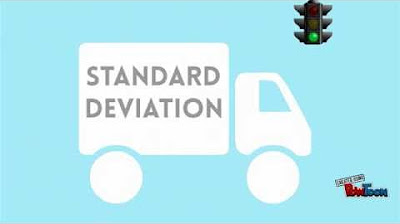Measures of Spread & Variability: Range, Variance, SD, etc| Statistics Tutorial | MarinStatsLectures
Summary
TLDRThis educational video delves into the realm of statistical variability, introducing various measures to quantify data's spread. Key concepts include the range, interquartile range (IQR), and the pivotal sample variance and standard deviation. The video emphasizes the importance of understanding these measures, not just the calculations, to grasp data's true nature. It also touches on the sensitivity of these measures to outliers and their practical implications in statistical analysis, all while maintaining an engaging and accessible tone.
Takeaways
- 📊 Variability is a key concept in statistics, focusing on how spread out or close observations are to each other.
- 🔢 The range, calculated by subtracting the minimum from the maximum value, provides a simple measure of variability.
- 📈 The interquartile range (IQR), which is the difference between the third and first quartiles, measures the spread of the middle 50% of the data and is less sensitive to outliers.
- 📉 Quartiles divide the dataset into quarters, with the first quartile (Q1) having 25% of observations below it and the third quartile (Q3) having 75% below it.
- 🧮 Sample variance, denoted as s^2, is calculated by averaging the squared differences from the sample mean and is sensitive to outliers.
- 📐 Sample standard deviation (SD), the square root of the sample variance, measures the average deviation from the mean and is also sensitive to outliers.
- ✂️ The IQR is often paired with the median as a measure of center, providing a robust estimate of the data's spread and center.
- 📚 The video emphasizes understanding the concepts behind these measures rather than focusing on the calculations, which are typically done using statistical software.
- 🔑 Greek letters like Sigma (Σ) are used to represent population parameters, while Latin letters are used for sample statistics, highlighting the difference between theoretical and empirical values.
- 💡 The video serves as an introduction to more detailed explanations of these concepts, encouraging viewers to look for further information in subsequent videos.
Q & A
What is the range and how is it calculated?
-The range is a simple measure of variability, calculated as the difference between the maximum and minimum values in a dataset. In the example provided, the range is 104 - 50 = 54 kilograms.
What is the interquartile range (IQR) and what does it represent?
-The interquartile range (IQR) is the difference between the third quartile (Q3) and the first quartile (Q1), representing the spread of the middle 50% of the data. It is not sensitive to outliers, making it a useful measure when extreme values are present. In the example, Q3 is 89 and Q1 is 64, so the IQR is 89 - 64 = 25 kilograms.
Why is the range less useful in analytical techniques?
-The range only considers the maximum and minimum values, which means it is highly sensitive to outliers. This makes it less reliable in analytical techniques, as it doesn’t give a full picture of the data’s variability.
How does the interquartile range handle outliers?
-The interquartile range (IQR) is robust against outliers because it focuses on the middle 50% of the data, excluding the top and bottom quartiles. This makes it less influenced by extreme values.
What is the sample variance and what does it measure?
-The sample variance measures the average of the squared deviations from the mean. It gives a sense of how far individual data points are from the sample mean. In the example, the variance is 317.7 kilograms squared.
Why is the formula for variance divided by n-1?
-The formula for variance uses n-1 (where n is the number of observations) to correct for bias in the estimation of population variance from a sample. This correction is known as Bessel’s correction.
What are the units of variance and how are they interpreted?
-The units of variance are the square of the original units of the data (in this case, kilograms squared). While variance provides useful information, the squared units make it harder to interpret, which is why standard deviation is often preferred.
What is the sample standard deviation and how is it related to variance?
-The sample standard deviation is the square root of the variance. It provides a measure of how much, on average, individual data points deviate from the mean. In this example, the standard deviation is 17.8 kilograms, making it easier to interpret than the variance.
How does the standard deviation handle outliers?
-Like variance, the standard deviation is sensitive to outliers. Extreme values can cause larger deviations, increasing the overall standard deviation.
Why is it important to pair the IQR with the median and variance with the mean?
-The interquartile range (IQR) should be paired with the median because both are resistant to outliers. On the other hand, variance and standard deviation should be paired with the mean, as both are sensitive to outliers and provide a fuller picture of data variability in distributions without extreme values.
Outlines

Esta sección está disponible solo para usuarios con suscripción. Por favor, mejora tu plan para acceder a esta parte.
Mejorar ahoraMindmap

Esta sección está disponible solo para usuarios con suscripción. Por favor, mejora tu plan para acceder a esta parte.
Mejorar ahoraKeywords

Esta sección está disponible solo para usuarios con suscripción. Por favor, mejora tu plan para acceder a esta parte.
Mejorar ahoraHighlights

Esta sección está disponible solo para usuarios con suscripción. Por favor, mejora tu plan para acceder a esta parte.
Mejorar ahoraTranscripts

Esta sección está disponible solo para usuarios con suscripción. Por favor, mejora tu plan para acceder a esta parte.
Mejorar ahoraVer Más Videos Relacionados

KULIAH STATISTIK (6) - UKURAN VARIABILITAS DATA

Ukuran Dispersi dan Variasi

Statistika Deskriptif Ukuran Pemusatan dan Penyebaran Data | Zulfanita Dien Rizqiana, S.Stat., M.Si.

Measures of Variability (Range, Standard Deviation, Variance)

Mode, Median, Mean, Range, and Standard Deviation (1.3)

Standard Deviation - Explained and Visualized
5.0 / 5 (0 votes)
